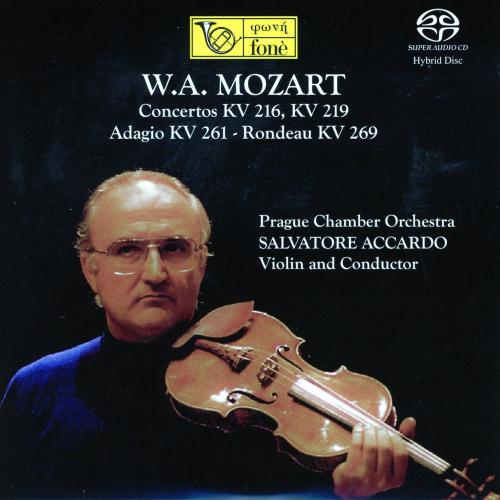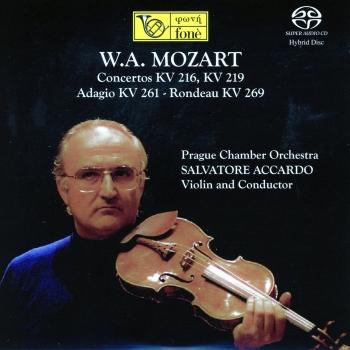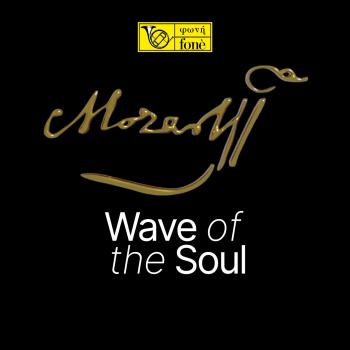
W.A. Mozart: Concertos KV 216, KV 219 - Adagio KV 261 - Rondeau KV 269 Prague Chamber Orchestra & Salvatore Accardo
Album info
Album-Release:
2021
HRA-Release:
15.12.2022
Label: fonè Records
Genre: Classical
Subgenre: Concertos
Artist: Prague Chamber Orchestra & Salvatore Accardo
Composer: Wolfgang Amadeus Mozart (1756-1791)
Album including Album cover Booklet (PDF)
- W.A. Mozart (1756 - 1791): Konzert fur Violine und Orchester Nr.3 G-dur KV 216:
- 1 Mozart: Konzert fur Violine und Orchester Nr.3 G-dur KV 216, allegro 08:48
- 2 Mozart: Konzert fur Violine und Orchester Nr.3 G-dur KV 216, adagio 09:32
- 3 Mozart: Konzert fur Violine und Orchester Nr.3 G-dur KV 216, Rondeau (Allegro) 07:16
- Konzert fur Violine und Orchester Nr.5 A-dur KV 219:
- 4 Mozart: Konzert fur Violine und Orchester Nr.5 A-dur KV 219, Allegro aperto 10:26
- 5 Mozart: Konzert fur Violine und Orchester Nr.5 A-dur KV 219, adagio 12:02
- 6 Mozart: Konzert fur Violine und Orchester Nr.5 A-dur KV 219, Rondeau (Tempo di Menuetto – Allegro - Tempo di Menuetto) 09:58
- Adagio fur Violine und Orchester in E-dur KV 261:
- 7 Mozart: Adagio fur Violine und Orchester in E-dur KV 261 08:57
- Rondeau fur Violine und Orchester in B-dur KV 269:
- 8 Mozart: Rondeau fur Violine und Orchester in B-dur KV 269, allegro 07:20
Info for W.A. Mozart: Concertos KV 216, KV 219 - Adagio KV 261 - Rondeau KV 269
The peculiar and almost impromptu importance of the genre of the Violin concerto in the catalogue of Mozart's musical production is highlighted by the very limited space of time in which the five most important compositions of this type appeared (all within the one year 1775). It is not easy to understand the reason for this constriction in time, especially if we consider that Mozart was one of the few great composers able to play the piano and the violin perfectly; whereas his activity as a virtuoso pianist remained a constant throughout his life, his activity as a concert violinist came to an abrupt and inexplicable end after fluorishing so signally in that 1775.
The peculiar and almost impromptu importance of the genre of the Violin concerto in the catalogue of Mozarts musical production is highlighted by the very limited space of time in which the five most important compositions of this type appeared (all within the one year 1775). It is not easy to understand the reason for this constriction in time, especially if we consider that Mozart was one of the few great composers able to play the piano and the violin perfectly; whereas his activity as a virtuoso pianist remained a constant throughout his life, his activity as a concert violinist came to an abrupt and inexplicable end after flourishing so signally in that 1775. Perhaps psychoanalysis alone will shed light on this peculiar aspect of Mozarts creativity, starting with an investigation of the complex relationship that the musician had with his father Leopold, an important violinist and theoretician, author of a seminal treatise (Versuch einer grundlichen Violinschule published coincidentally in the very year in which Wolfgang was born). And yet the notion of an inferiority complex would seem to be contradicted by a famous letter from Leopold to his son: referring to Wolfgangs recent success as a concert violinist in Germany, Leopold writes: Im not at all surprised. You yourself do not realize how well you play the violin. Mozart undoubtedly used the five Violin concertos that he composed in 1775 (KV 207, 211, 216, 218 and 219) for his own activity as a soloist in his home town in Salzburg. Only later did these works become part of the repertoire of the violinist Gaetano Brunetti, who entered the court of Prince Colloredo as official soloist. These concertos, which reflect French style gallant but also borrow from the grand Italian violin tradition, contain some of Mozarts most beautiful and inspired melodies.
Prague Chamber Orchestra
Salvatore Accardo, violin, conductor
No biography found.
Booklet for W.A. Mozart: Concertos KV 216, KV 219 - Adagio KV 261 - Rondeau KV 269











